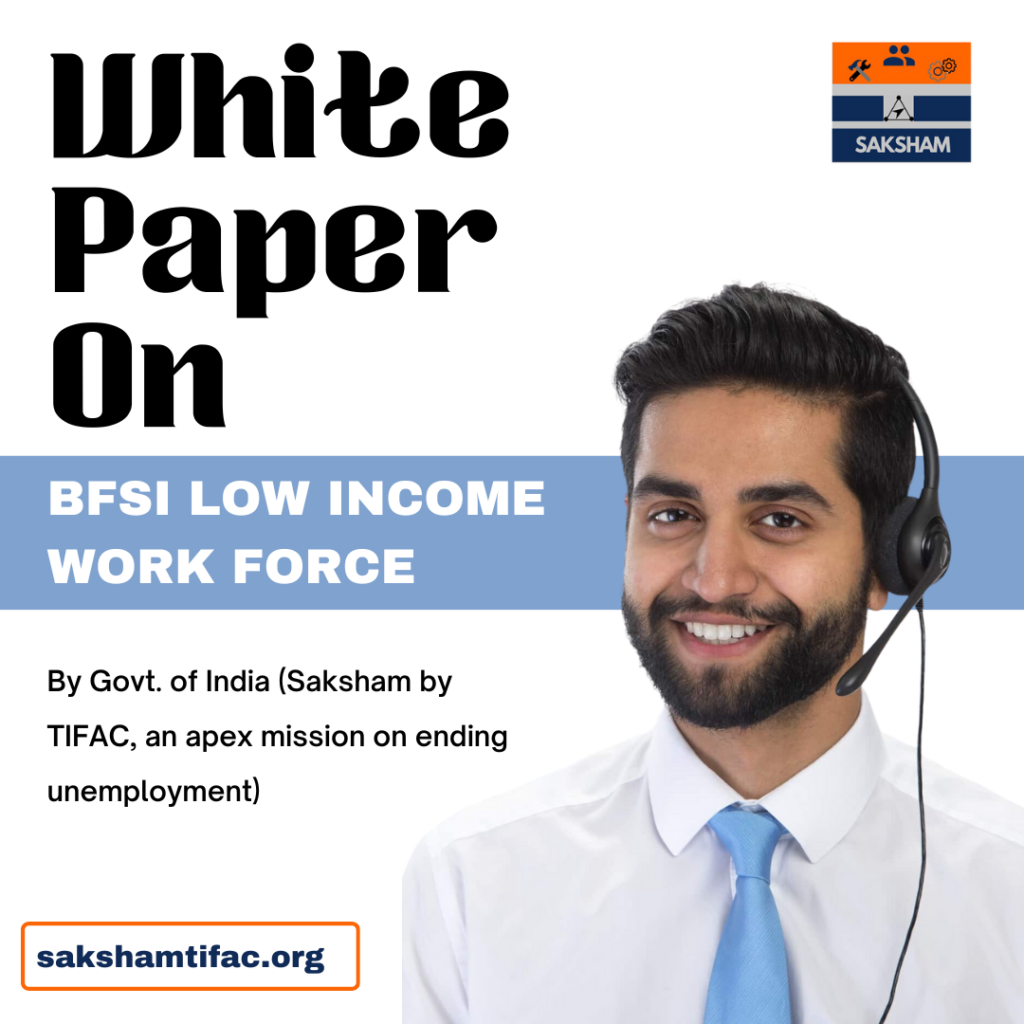Human centred Artificial Intelligence is needed to personalise empowerment of the BFSI workforce, leading to higher stability and better performance, ultimately enhancing industry’s growth.

BFSI industry employs more than 72,00,000 citizens of India in the low income segment, belonging to field sales agents, debt recovery agents, document verification agents, branch upselling agents, calling agents, insurance agents, and several other roles. This includes directly employed workforce, contractual workforce, as well as self-employed individuals.
One of the largest employers of the low income citizens of India, BFSI industry also faces an attrition of around 5-10% per month in this segment, on a monthly basis. The overall attrition numbers in BFSI stand at 35% per annum, but when the complete spectrum of the low income segment is considered, the numbers are staggeringly high.
What is the impact of this workforce on the industry?
This workforce is the backbone of the industry. Its growth is dependent on this workforce, especially the workforce that belongs to the smaller cities and towns of India.
Let’s look at some numbers.
Average money spent in recruitment of one member (including recruitment costs, partial cost of HR manager, partial cost of infrastructure used for recruitment, cost of onboarding and documentation, etc.): Rs 10000
Average money spent in training of one person before they become productive (including salary costs, training costs if any, etc): Rs 25000
Average cost of supervisor efficiency loss due to a new employee in their team: Rs 5000
That’s a cost of Rs 40000 for one person. And considering average attrition of around 5% per month (assuming reduction in inefficiencies if such costs are incurred), that’s a loss of Rs 1440 crores (180 million USD) per month to the industry.
Now, if we add to that the productivity loss, due to inefficient performance by the members of this workforce, which is not a function of their skill gap but more of a function of the industry’s lack of understanding of this workforce, the numbers increase significantly.
Our analysis says up to 5% of performance of this workforce can be enhanced without any structured skill based training, through use of nudge-based skilling and enhanced engagement.
With such numbers staring at us, it is imperative to say that this workforce can transform the BFSI industry, if the inefficiencies in monitoring them, recruiting them, or engaging with them, are sorted out.
We will see increased bottom line, due to reduced expenses, and increased top line, due to enhanced performances.
If this workforce is so important, why has the BFSI industry failed to crack this?
Is BFSI industry missing the true pulse of its workforce?
The answer is a resounding Yes (at least until the writing of this paper).
Here are some outputs based on qualitative surveys of people from the industry:
- Most people managers in the industry treat the low income workforce as resources to achieve their targets, without any pulse on their hidden aspirations, unknown abilities, behavioural traits, and mindset.
- This nature comes from the top, where on-ground knowledge of the feelings and beliefs of this workforce is not known in the right way. It is also a function of the fact that majority of this workforce does not work from the central offices, and hence it’s natural to miss the pulse, unless some scaleable intervention is used.
- These are some of the main areas identified where the low income workforce is not rightly monitored or conversed with:
- Inefficient expectation setting
- Dignity in work with contextualised understanding of trials and tribulations of the workforce
- Lack of engagement with society and community of the workforce
These outputs show that the true pulse of this workforce is missing, especially when it comes to individualised knowledge.
Here are some sample insights into this workforce, derived through the Neural Ocean (intelligent data lake) of Sapio Analytics, agency appointed by the Government of India (TIFAC) to help end unemployment in India.

Caption: Sample insights derived from intelligent analytics, representing some true pulse of this workforce. The real pulse is only possible if individual level analytics is done, and each person is treated uniquely in their evaluation.
The insights show that true pulse on this workforce is needed.
Gap between perception of skills and actual skills
One of the examples where true pulse is missing is skill itself. If we look at the perception of skills in the low income workforce, as evaluated by their seniors from the company, we find that there is a lack of understanding of what is hidden.
In many cases, especially when it comes to workforce belonging to and operating from smaller towns/cities, the ability of a person is not rightly recognised and hence they are not motivated based on this understanding. Interestingly, this recognition is not possible through questions asked to the person, because the person themselves may not be aware of their actual skill potential.
The following analysis shows the extent of this gap.
Through a set of deeply personal and empathetic conversations with thousands of citizens of this workforce, our agency has been able to identify this gap. We found that those belonging to the metro cities may have this gap issue lesser than those belonging to non metro cities.

Caption: Showing how there is a gap between perception of skills and actual skills, where skills include soft skills, of the low income workforce in BFSI, working out of Metro, Tier 1 and Tier 2 cities

Caption: Showing how there is a gap between perception of skills and actual skills, where skills include soft skills, of the low income workforce in BFSI, working out of smaller cities
The Missing Transition between Roles
The recruitment industry serving the BFSI workforce, the Human Resources industry managing this workforce, need to expand their lens to understand that the empowered workforce that they are looking for, may come from outside this industry.
In the recent past, Saksham has seen the following:
- Those working as delivery personnel in quick commerce company got identified as being good with customers, and became high performers as field sales personnel in the BFSI industry
- A driver working for a ride hailing company, as a self employed individual, took a leap of faith based on his ability to engage with customers and convince them to give good ratings, becoming a Debt Recovery Agent.
The current industry misses these nuances, but when Government of India sees it from the outside, its able to see a world where transitions between roles are becoming seamless, and this workforce is now seeing a career path, a trajectory of their growth!
With this deep understanding of the individuals across industries, BFSI can also be transformed.
Dignity, Money and Purpose are important for this workforce
The BFSI industry may try to attract and retain its workforce through the carrot of incentives, but this workforce needs something deeper than that.
Though each individual comes with their own aspirations and desires that need to be understood on a personal level, we have created a simplified representation of the major needs, showing retention has some drivers that have not been fully understood by most.
Here are the drivers from the context of someone belonging to a family that can be considered belonging to middle or high socio-economic index (index used for this definition is as per the definition in the Smart Digital Census done for the state of Uttar Pradesh by Sapio Analytics).

Caption: Here we see Respect in Society becoming one of the critical drivers in ensuring satisfaction and retention, to the extent that there are recorded cases of employees not leaving for a higher paying job if they are rightly engaged with dignity
Do the incentives and rewards match the desires?
While the BFSI industry is known for incentivising its performing workforce, the concept of incentives and rewards needs a revision.
Each individual has different desires, and their personal desires should be considered to run an intervention with them. With such personalised knowledge, the industry can see a better outcome of any reward.
Let’s take the example of field agents, and see some of the rewards that they cherish. This is a simplified collated version of the rewards for the purpose of this representation.

Caption: In the metro cities, the field agents have a knack for travel and upskilling; and the right incentives related to new learning, especially if done along with travel, makes them appreciate the reward more.
When the non-metro workforce is considered, we see a different set of options, thus showing micro evaluation will give even deeper changes.

Caption: The field agents in the non-metro cities like community events, and want to be appreciated and recognised in their BFSI community, besides also appreciating recognition in society and family
The above examples show how true pulse is needed, and how the right dose of true pulse can transform every aspect of engagement of this workforce, leading to a true empowerment and reformation.
How to get this True Pulse and how can businesses empower this workforce?
There are multiple ways to empower this workforce, but the most effective one is to use Artificial Intelligence and provide an AI guide to each member of this workforce. As they get an AI guide, they will be able to get the right guidance, while also generating intelligence that can be further used to get their true pulse.
Companies need this empowerment at the workforce level to enhance their existence.
Where does the Government of India stand?
The government believes in the use of new age technologies in helping empower the BFSI workforce of India, and requests companies to start adopting these technologies. The government believes in providing direct support to companies, through its own systems, under its mission Saksham, aimed at ending unemployment in India.
Once companies start adopting these, they are expected to empower their workforce, retain them, reform them by enhancing their performance, and increase the companies’ revenues or profits in the process.
And there is an additional reason that Government of India is offering to the companies in the industry to get this true pulse.
- If a company has more than 50% of its workforce empowered, where empowerment is defined as individualised guidance for each person, and it follows the protocols defined by Saksham, it can be recognised as a “Company with Samarth Citizens”.
- Such recognition comes with awards, branding, specific interventions, and much more.
The BFSI industry can ride on the power of its empowered low income workforce into successes that were never seen before. And, in the process, creating a stronger economy for India, with empowered and more satisfied citizens.
Special thanks to Ashwin Srivastava, CEO of Sapio Analytics, Government of Maharashtra, Swavlambi Bharat Abhiyan (SBA), and various Government of India bodies, whose support was used in creating this.
All research is copyrighted with our agency Sapio Analytics, whose Neural Ocean was used for the above.



